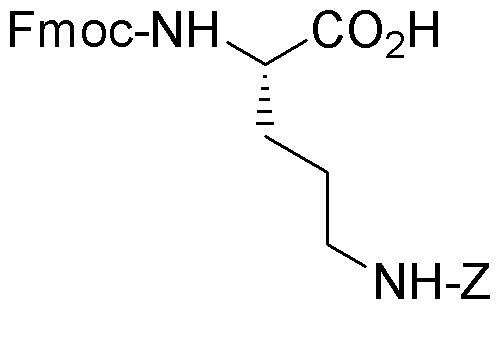Na-Fmoc-Nd-Z-L-ornithine is widely utilized in research focused on:
- Peptide Synthesis: This compound serves as a key building block in the synthesis of peptides, particularly in solid-phase peptide synthesis, enhancing the efficiency and yield of desired products.
- Drug Development: It plays a crucial role in the development of peptide-based therapeutics, offering potential treatments for various diseases, including cancer and metabolic disorders.
- Bioconjugation: The chemical is used in bioconjugation processes to attach peptides to other biomolecules, facilitating targeted drug delivery systems that improve therapeutic efficacy.
- Research in Neuroscience: It is applied in the study of neuropeptides, contributing to the understanding of neurological pathways and potential treatments for neurodegenerative diseases.
- Protein Engineering: The compound aids in the design of modified proteins with enhanced stability and functionality, which is essential for various biotechnological applications.
General Information
Properties
Safety and Regulations
Applications
Na-Fmoc-Nd-Z-L-ornithine is widely utilized in research focused on:
- Peptide Synthesis: This compound serves as a key building block in the synthesis of peptides, particularly in solid-phase peptide synthesis, enhancing the efficiency and yield of desired products.
- Drug Development: It plays a crucial role in the development of peptide-based therapeutics, offering potential treatments for various diseases, including cancer and metabolic disorders.
- Bioconjugation: The chemical is used in bioconjugation processes to attach peptides to other biomolecules, facilitating targeted drug delivery systems that improve therapeutic efficacy.
- Research in Neuroscience: It is applied in the study of neuropeptides, contributing to the understanding of neurological pathways and potential treatments for neurodegenerative diseases.
- Protein Engineering: The compound aids in the design of modified proteins with enhanced stability and functionality, which is essential for various biotechnological applications.
Documents
Safety Data Sheets (SDS)
The SDS provides comprehensive safety information on handling, storage, and disposal of the product.
Product Specification (PS)
The PS provides a comprehensive breakdown of the product’s properties, including chemical composition, physical state, purity, and storage requirements. It also details acceptable quality ranges and the product's intended applications.
Certificates of Analysis (COA)
Search for Certificates of Analysis (COA) by entering the products Lot Number. Lot and Batch Numbers can be found on a product’s label following the words ‘Lot’ or ‘Batch’.
Numéro de catalogue
Numéro de lot/série
Certificates Of Origin (COO)
This COO confirms the country where the product was manufactured, and also details the materials and components used in it and whether it is derived from natural, synthetic, or other specific sources. This certificate may be required for customs, trade, and regulatory compliance.
Numéro de catalogue
Numéro de lot/série
Safety Data Sheets (SDS)
The SDS provides comprehensive safety information on handling, storage, and disposal of the product.
DownloadProduct Specification (PS)
The PS provides a comprehensive breakdown of the product’s properties, including chemical composition, physical state, purity, and storage requirements. It also details acceptable quality ranges and the product's intended applications.
DownloadCertificates of Analysis (COA)
Search for Certificates of Analysis (COA) by entering the products Lot Number. Lot and Batch Numbers can be found on a product’s label following the words ‘Lot’ or ‘Batch’.
Numéro de catalogue
Numéro de lot/série
Certificates Of Origin (COO)
This COO confirms the country where the product was manufactured, and also details the materials and components used in it and whether it is derived from natural, synthetic, or other specific sources. This certificate may be required for customs, trade, and regulatory compliance.


